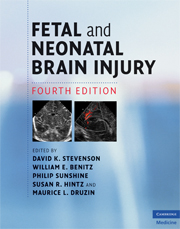Book contents
- Frontmatter
- Contents
- List of contributors
- Foreword
- Preface
- Section 1 Epidemiology, pathophysiology, and pathogenesis of fetal and neonatal brain injury
- Section 2 Pregnancy, labor, and delivery complications causing brain injury
- 5 Prematurity and complications of labor and delivery
- 6 Risks and complications of multiple gestations
- 7 Intrauterine growth restriction
- 8 Maternal diseases that affect fetal development
- 9 Obstetrical conditions and practices that affect the fetus and newborn
- 10 Fetal and neonatal injury as a consequence of maternal substance abuse
- 11 Hypertensive disorders of pregnancy
- 12 Complications of labor and delivery
- 13 Fetal response to asphyxia
- 14 Antepartum evaluation of fetal well-being
- 15 Intrapartum evaluation of the fetus
- Section 3 Diagnosis of the infant with brain injury
- Section 4 Specific conditions associated with fetal and neonatal brain injury
- Section 5 Management of the depressed or neurologically dysfunctional neonate
- Section 6 Assessing outcome of the brain-injured infant
- Index
- Plate section
- References
10 - Fetal and neonatal injury as a consequence of maternal substance abuse
from Section 2 - Pregnancy, labor, and delivery complications causing brain injury
Published online by Cambridge University Press: 12 January 2010
- Frontmatter
- Contents
- List of contributors
- Foreword
- Preface
- Section 1 Epidemiology, pathophysiology, and pathogenesis of fetal and neonatal brain injury
- Section 2 Pregnancy, labor, and delivery complications causing brain injury
- 5 Prematurity and complications of labor and delivery
- 6 Risks and complications of multiple gestations
- 7 Intrauterine growth restriction
- 8 Maternal diseases that affect fetal development
- 9 Obstetrical conditions and practices that affect the fetus and newborn
- 10 Fetal and neonatal injury as a consequence of maternal substance abuse
- 11 Hypertensive disorders of pregnancy
- 12 Complications of labor and delivery
- 13 Fetal response to asphyxia
- 14 Antepartum evaluation of fetal well-being
- 15 Intrapartum evaluation of the fetus
- Section 3 Diagnosis of the infant with brain injury
- Section 4 Specific conditions associated with fetal and neonatal brain injury
- Section 5 Management of the depressed or neurologically dysfunctional neonate
- Section 6 Assessing outcome of the brain-injured infant
- Index
- Plate section
- References
Summary
Introduction
Substance abuse is widely prevalent in our society, and women in their child-bearing years are not immune to this epidemic. In addition to the many problems substance abuse causes for these women, it may also place the children they are carrying at risk for lifelong sequelae. Despite the paucity of information on the safety of drugs in pregnancy and lactation, virtually all pregnant women are exposed to prescription and/or non-prescription drugs in some form. The 1991 World Health Organization (WHO) International Survey on Drug Utilization in Pregnancy observed that 86% of women surveyed took medication in pregnancy, with an average of 2.9 prescriptions per woman, excluding over-the-counter and herbal preparations. It is estimated that approximately 10% of pregnant women are exposed to illicit substances. The purpose of this chapter is to describe the fetal and neonatal effects of various legal and illegal sensorium-altering substances ingested by pregnant women.
Drug distribution in pregnancy
It is important to first understand general principles of drug distribution during pregnancy, including the roles of the placenta and breast in biotransformation and secretion. The characteristics that favor transport of a drug across the lipoprotein barriers between the circulation and the central and peripheral nervous systems include high lipid solubility, minimal ionization at physiologic pH, low protein-binding, and low molecular weight.
- Type
- Chapter
- Information
- Fetal and Neonatal Brain Injury , pp. 110 - 126Publisher: Cambridge University PressPrint publication year: 2009



